
Tree Care Basics: A Starter Guide
Problems Your Tree Might Have (And What To Do About It)
Johnni Knight
1. Dead Branches
Dead branches can happen on any tree for many different reasons. Some of the most common reasons for dead branches include disease, added weight (from fruit, snow, or leaves), high winds, hail, and lightning strikes. Dead branches not only look bad, but they can also be dangerous. A dead branch can rot and easily break off at any moment, hitting power lines, rooftops, fences, or even people.
Some dead branches are close to the ground, small, and can be handled with a pair of large pruning shears, but most often, dead branches are high up in a tree and require the use of a chainsaw to bring them down, in that case, you should really leave the job to the professionals. Tree care professionals can take care of the job safely with minimal damage to the rest of the tree. They have years of experience and all the right equipment for the task.
2. Overgrowth
Trees grow quite quickly, which is usually a good thing. The trouble comes when a tree starts to grow next to a house, a fence, over a road, into other trees, or simply out of the shape you want it to. Some varieties of trees are particularly prone to overgrowth since they grow rapidly. Weeping willows can shoot up 10 feet in one year, and a dawn redwood can reach a hundred feet when all is said and done.
If your tree is getting out of line, there are a few things you can do. One option is careful pruning or cutting back of wayward branches. Another possible option for redirecting a tree is to try to gently redirect the growth of the tree using ropes or weights, this works best with young trees. As a last resort, you can cut down the tree.
A tree care service can advise you of your options and give you specific guidance related to the type of tree you have, its age, and the problem you are looking at.
3. Disease
Trees are just like other living organisms, they grow, soak up nutrients, and are susceptible to disease. There are many kinds of diseases that might affect your tree. Some of the most common tree diseases are root rot, canker rot, and needle cast. Symptoms of disease in your tree can vary from brown blighted spots on leaves or needles to seeping cankers on the trunks.
Each tree disease is handled differently, and your local tree care service has most likely seen and dealt with the diseases common in your area, so they can help you find the right treatment.
Share

Proper tree care is an essential part of maintaining your property's appearance and overall well-being. After all, neglected trees can quickly become safety hazards if limbs should fall and damage your property. That's why it's important that you know how to take care of your trees. Luckily, this site is here to help. With the information on this site, you'll be able to better understand the different needs of each type of tree on your land. That way, you can tailor your tree care accordingly and you'll know when you should call a tree service for more help and ongoing care.
-
Why You Should Hire a Tree Company for Your Property 17 July 2024